Intercultural Competence: Analyzing a Cross-Cultural Business Scenario
VerifiedAdded on 2023/01/16
|6
|974
|40
Report
AI Summary
This report analyzes a case study involving an American manager, Mark, facing communication and trust issues with his Indian employees. The assignment applies intercultural theories, including Edward Hall's Intercultural Communication theory, Hofstede's Cultural Dimensions theory, and Trompenaars' Cultural Dimensions theory, to explain the cross-cultural problems. It highlights the differences between American and Indian cultures, particularly in communication styles, power distance, individualism, and long-term orientation. The report provides advice to Mark, emphasizing the importance of building relationships, providing detailed information, and understanding the cultural nuances to improve his interactions with his Indian employees. The analysis demonstrates the application of these theories in a business context and offers practical solutions for effective cross-cultural management.
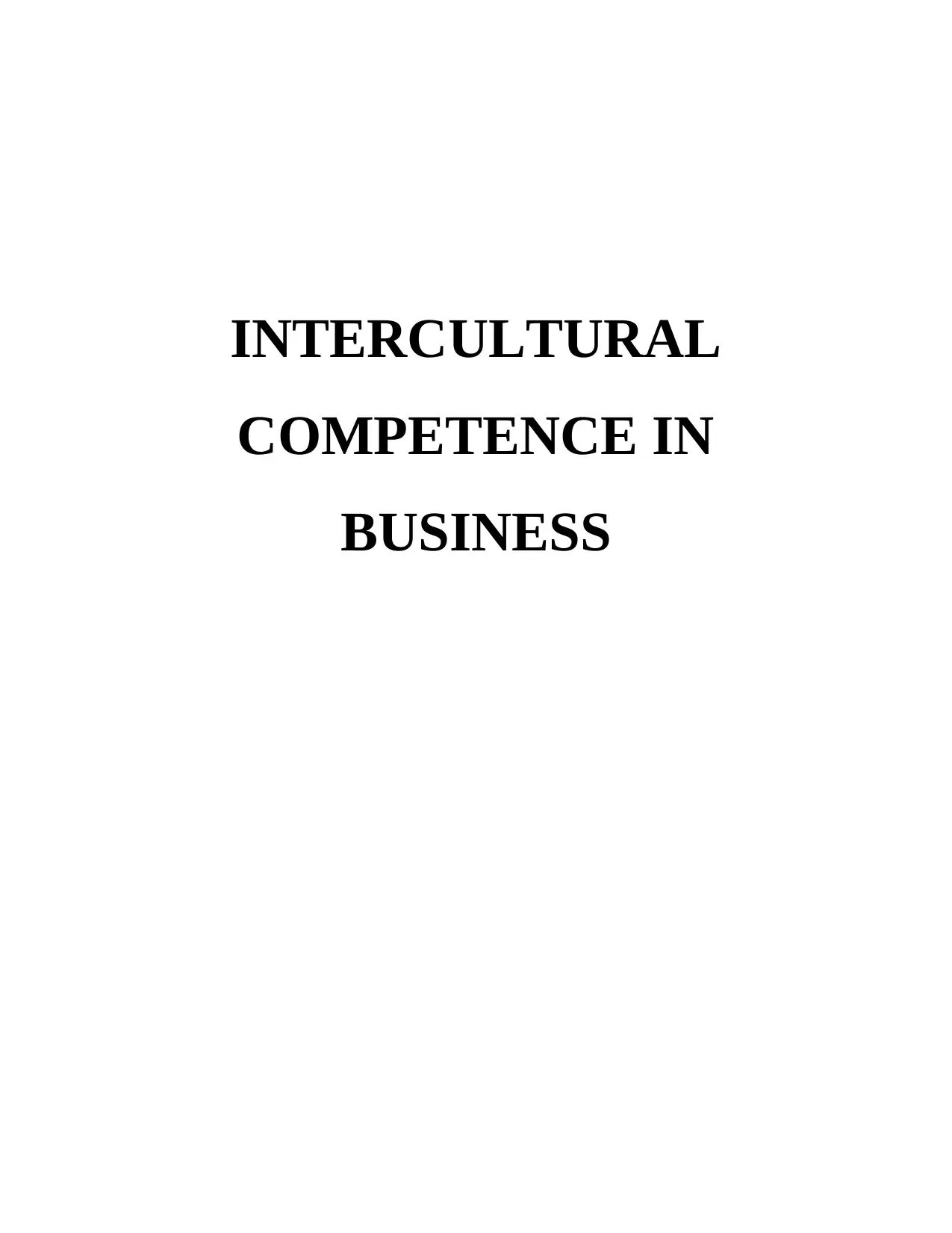
INTERCULTURAL
COMPETENCE IN
BUSINESS
COMPETENCE IN
BUSINESS
Paraphrase This Document
Need a fresh take? Get an instant paraphrase of this document with our AI Paraphraser
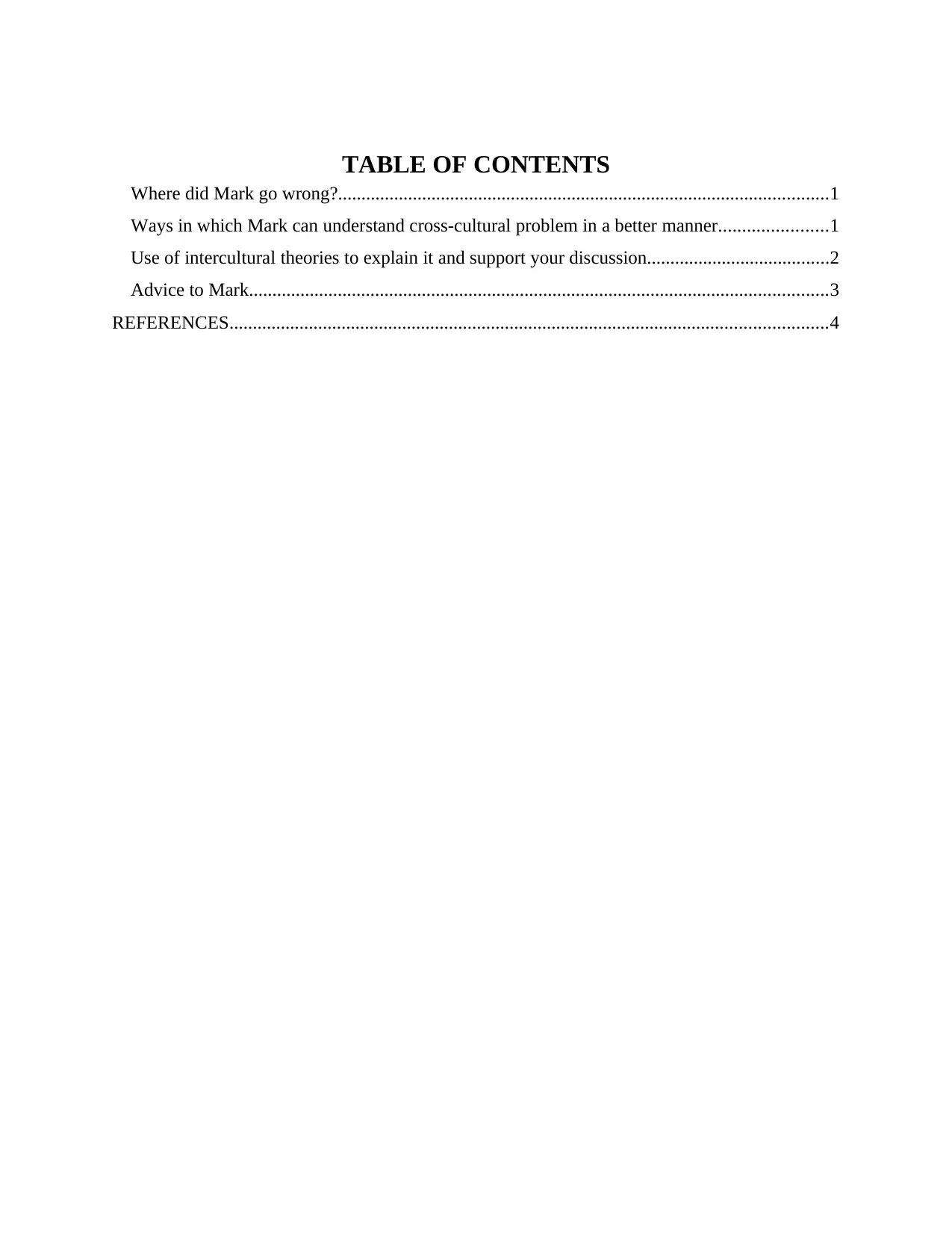
TABLE OF CONTENTS
Where did Mark go wrong?.........................................................................................................1
Ways in which Mark can understand cross-cultural problem in a better manner.......................1
Use of intercultural theories to explain it and support your discussion.......................................2
Advice to Mark............................................................................................................................3
REFERENCES................................................................................................................................4
Where did Mark go wrong?.........................................................................................................1
Ways in which Mark can understand cross-cultural problem in a better manner.......................1
Use of intercultural theories to explain it and support your discussion.......................................2
Advice to Mark............................................................................................................................3
REFERENCES................................................................................................................................4
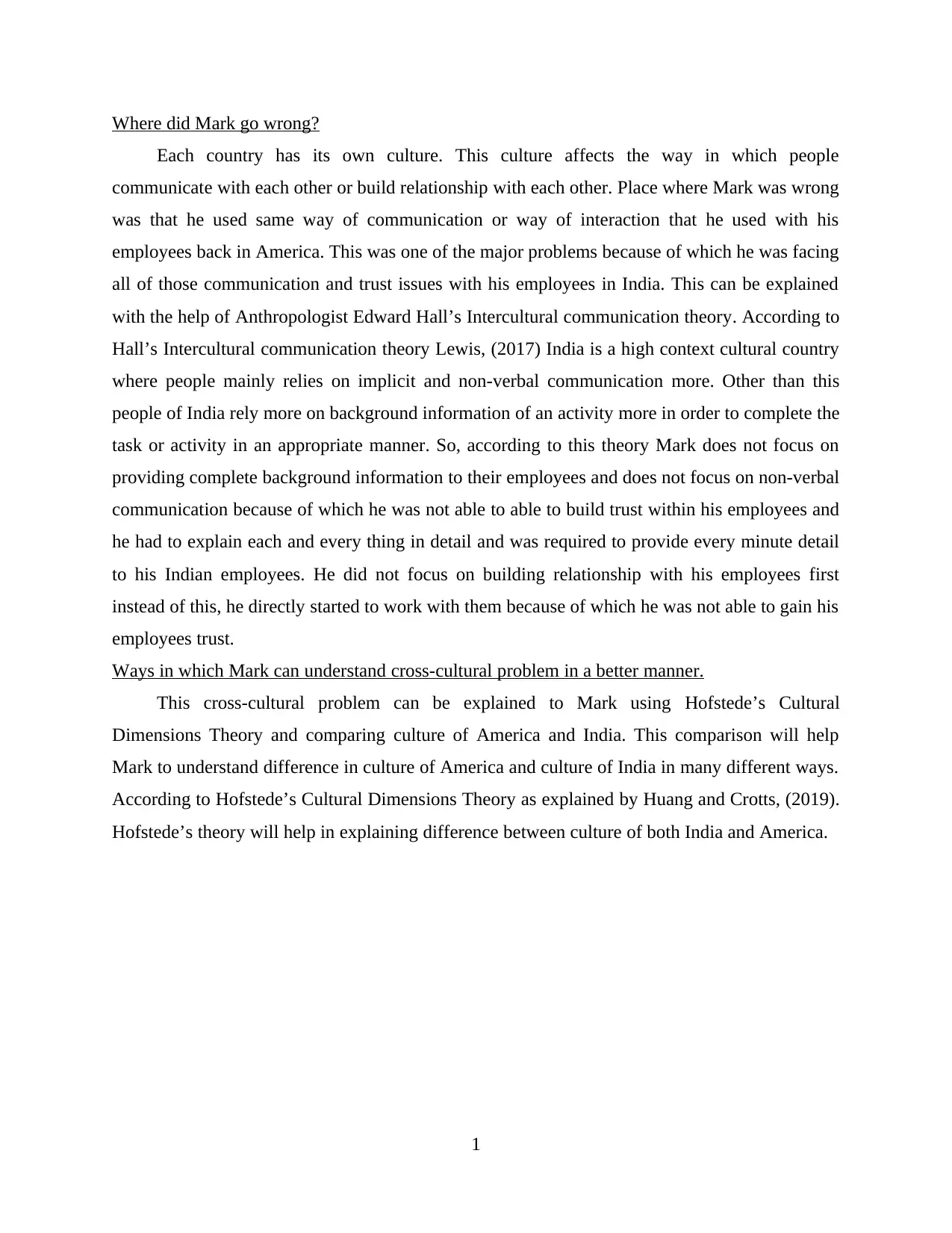
Where did Mark go wrong?
Each country has its own culture. This culture affects the way in which people
communicate with each other or build relationship with each other. Place where Mark was wrong
was that he used same way of communication or way of interaction that he used with his
employees back in America. This was one of the major problems because of which he was facing
all of those communication and trust issues with his employees in India. This can be explained
with the help of Anthropologist Edward Hall’s Intercultural communication theory. According to
Hall’s Intercultural communication theory Lewis, (2017) India is a high context cultural country
where people mainly relies on implicit and non-verbal communication more. Other than this
people of India rely more on background information of an activity more in order to complete the
task or activity in an appropriate manner. So, according to this theory Mark does not focus on
providing complete background information to their employees and does not focus on non-verbal
communication because of which he was not able to able to build trust within his employees and
he had to explain each and every thing in detail and was required to provide every minute detail
to his Indian employees. He did not focus on building relationship with his employees first
instead of this, he directly started to work with them because of which he was not able to gain his
employees trust.
Ways in which Mark can understand cross-cultural problem in a better manner.
This cross-cultural problem can be explained to Mark using Hofstede’s Cultural
Dimensions Theory and comparing culture of America and India. This comparison will help
Mark to understand difference in culture of America and culture of India in many different ways.
According to Hofstede’s Cultural Dimensions Theory as explained by Huang and Crotts, (2019).
Hofstede’s theory will help in explaining difference between culture of both India and America.
1
Each country has its own culture. This culture affects the way in which people
communicate with each other or build relationship with each other. Place where Mark was wrong
was that he used same way of communication or way of interaction that he used with his
employees back in America. This was one of the major problems because of which he was facing
all of those communication and trust issues with his employees in India. This can be explained
with the help of Anthropologist Edward Hall’s Intercultural communication theory. According to
Hall’s Intercultural communication theory Lewis, (2017) India is a high context cultural country
where people mainly relies on implicit and non-verbal communication more. Other than this
people of India rely more on background information of an activity more in order to complete the
task or activity in an appropriate manner. So, according to this theory Mark does not focus on
providing complete background information to their employees and does not focus on non-verbal
communication because of which he was not able to able to build trust within his employees and
he had to explain each and every thing in detail and was required to provide every minute detail
to his Indian employees. He did not focus on building relationship with his employees first
instead of this, he directly started to work with them because of which he was not able to gain his
employees trust.
Ways in which Mark can understand cross-cultural problem in a better manner.
This cross-cultural problem can be explained to Mark using Hofstede’s Cultural
Dimensions Theory and comparing culture of America and India. This comparison will help
Mark to understand difference in culture of America and culture of India in many different ways.
According to Hofstede’s Cultural Dimensions Theory as explained by Huang and Crotts, (2019).
Hofstede’s theory will help in explaining difference between culture of both India and America.
1
⊘ This is a preview!⊘
Do you want full access?
Subscribe today to unlock all pages.

Trusted by 1+ million students worldwide
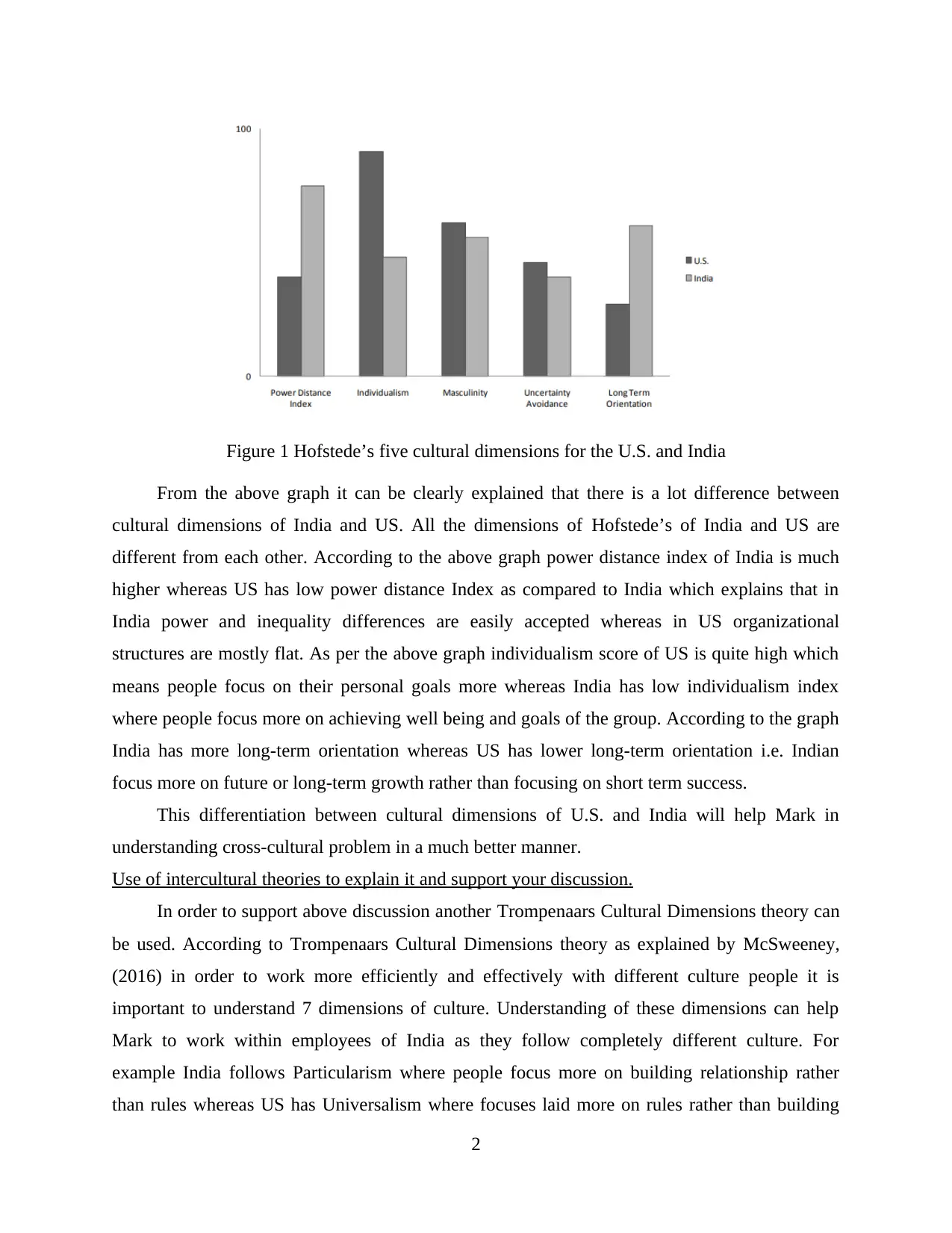
Figure 1 Hofstede’s five cultural dimensions for the U.S. and India
From the above graph it can be clearly explained that there is a lot difference between
cultural dimensions of India and US. All the dimensions of Hofstede’s of India and US are
different from each other. According to the above graph power distance index of India is much
higher whereas US has low power distance Index as compared to India which explains that in
India power and inequality differences are easily accepted whereas in US organizational
structures are mostly flat. As per the above graph individualism score of US is quite high which
means people focus on their personal goals more whereas India has low individualism index
where people focus more on achieving well being and goals of the group. According to the graph
India has more long-term orientation whereas US has lower long-term orientation i.e. Indian
focus more on future or long-term growth rather than focusing on short term success.
This differentiation between cultural dimensions of U.S. and India will help Mark in
understanding cross-cultural problem in a much better manner.
Use of intercultural theories to explain it and support your discussion.
In order to support above discussion another Trompenaars Cultural Dimensions theory can
be used. According to Trompenaars Cultural Dimensions theory as explained by McSweeney,
(2016) in order to work more efficiently and effectively with different culture people it is
important to understand 7 dimensions of culture. Understanding of these dimensions can help
Mark to work within employees of India as they follow completely different culture. For
example India follows Particularism where people focus more on building relationship rather
than rules whereas US has Universalism where focuses laid more on rules rather than building
2
From the above graph it can be clearly explained that there is a lot difference between
cultural dimensions of India and US. All the dimensions of Hofstede’s of India and US are
different from each other. According to the above graph power distance index of India is much
higher whereas US has low power distance Index as compared to India which explains that in
India power and inequality differences are easily accepted whereas in US organizational
structures are mostly flat. As per the above graph individualism score of US is quite high which
means people focus on their personal goals more whereas India has low individualism index
where people focus more on achieving well being and goals of the group. According to the graph
India has more long-term orientation whereas US has lower long-term orientation i.e. Indian
focus more on future or long-term growth rather than focusing on short term success.
This differentiation between cultural dimensions of U.S. and India will help Mark in
understanding cross-cultural problem in a much better manner.
Use of intercultural theories to explain it and support your discussion.
In order to support above discussion another Trompenaars Cultural Dimensions theory can
be used. According to Trompenaars Cultural Dimensions theory as explained by McSweeney,
(2016) in order to work more efficiently and effectively with different culture people it is
important to understand 7 dimensions of culture. Understanding of these dimensions can help
Mark to work within employees of India as they follow completely different culture. For
example India follows Particularism where people focus more on building relationship rather
than rules whereas US has Universalism where focuses laid more on rules rather than building
2
Paraphrase This Document
Need a fresh take? Get an instant paraphrase of this document with our AI Paraphraser
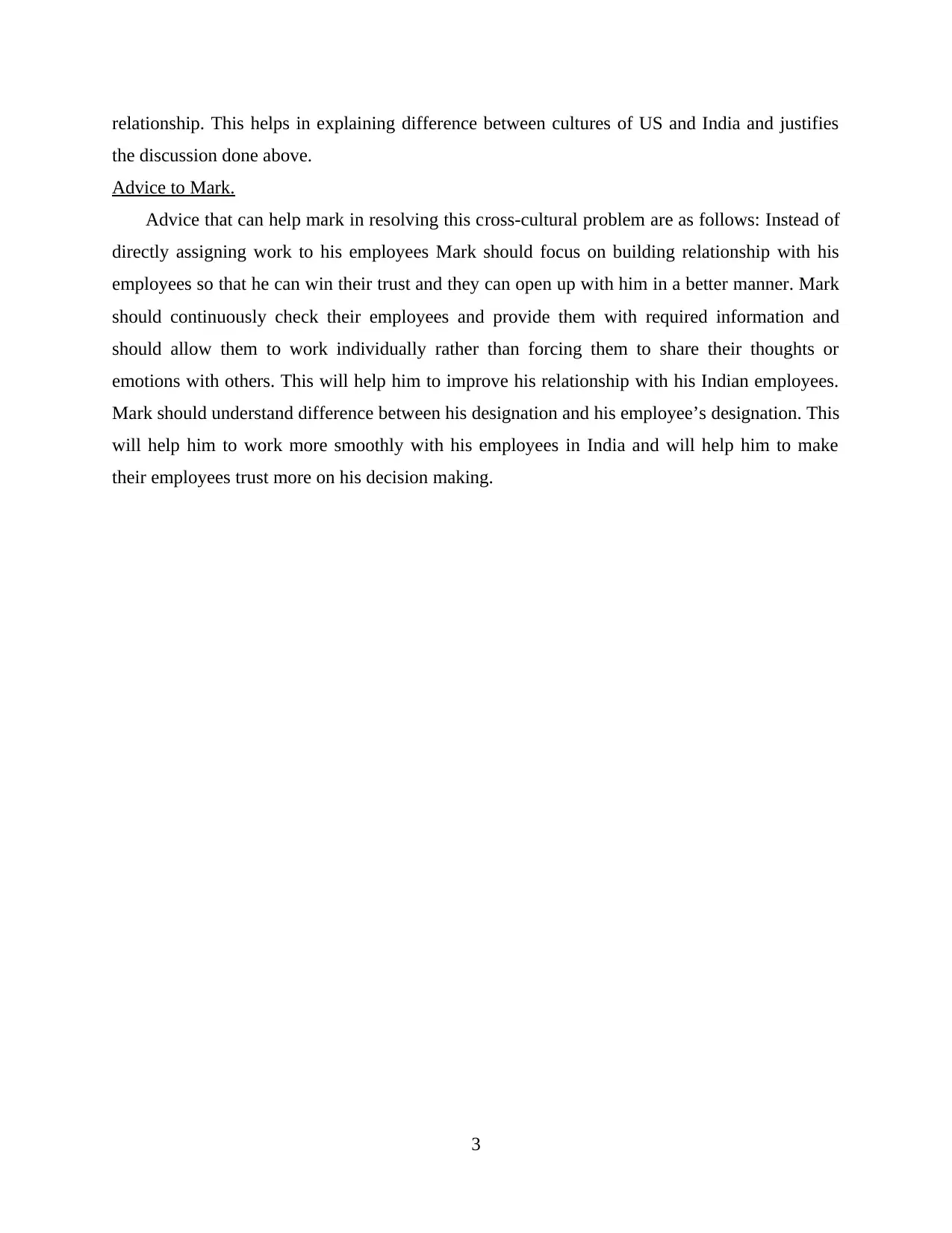
relationship. This helps in explaining difference between cultures of US and India and justifies
the discussion done above.
Advice to Mark.
Advice that can help mark in resolving this cross-cultural problem are as follows: Instead of
directly assigning work to his employees Mark should focus on building relationship with his
employees so that he can win their trust and they can open up with him in a better manner. Mark
should continuously check their employees and provide them with required information and
should allow them to work individually rather than forcing them to share their thoughts or
emotions with others. This will help him to improve his relationship with his Indian employees.
Mark should understand difference between his designation and his employee’s designation. This
will help him to work more smoothly with his employees in India and will help him to make
their employees trust more on his decision making.
3
the discussion done above.
Advice to Mark.
Advice that can help mark in resolving this cross-cultural problem are as follows: Instead of
directly assigning work to his employees Mark should focus on building relationship with his
employees so that he can win their trust and they can open up with him in a better manner. Mark
should continuously check their employees and provide them with required information and
should allow them to work individually rather than forcing them to share their thoughts or
emotions with others. This will help him to improve his relationship with his Indian employees.
Mark should understand difference between his designation and his employee’s designation. This
will help him to work more smoothly with his employees in India and will help him to make
their employees trust more on his decision making.
3
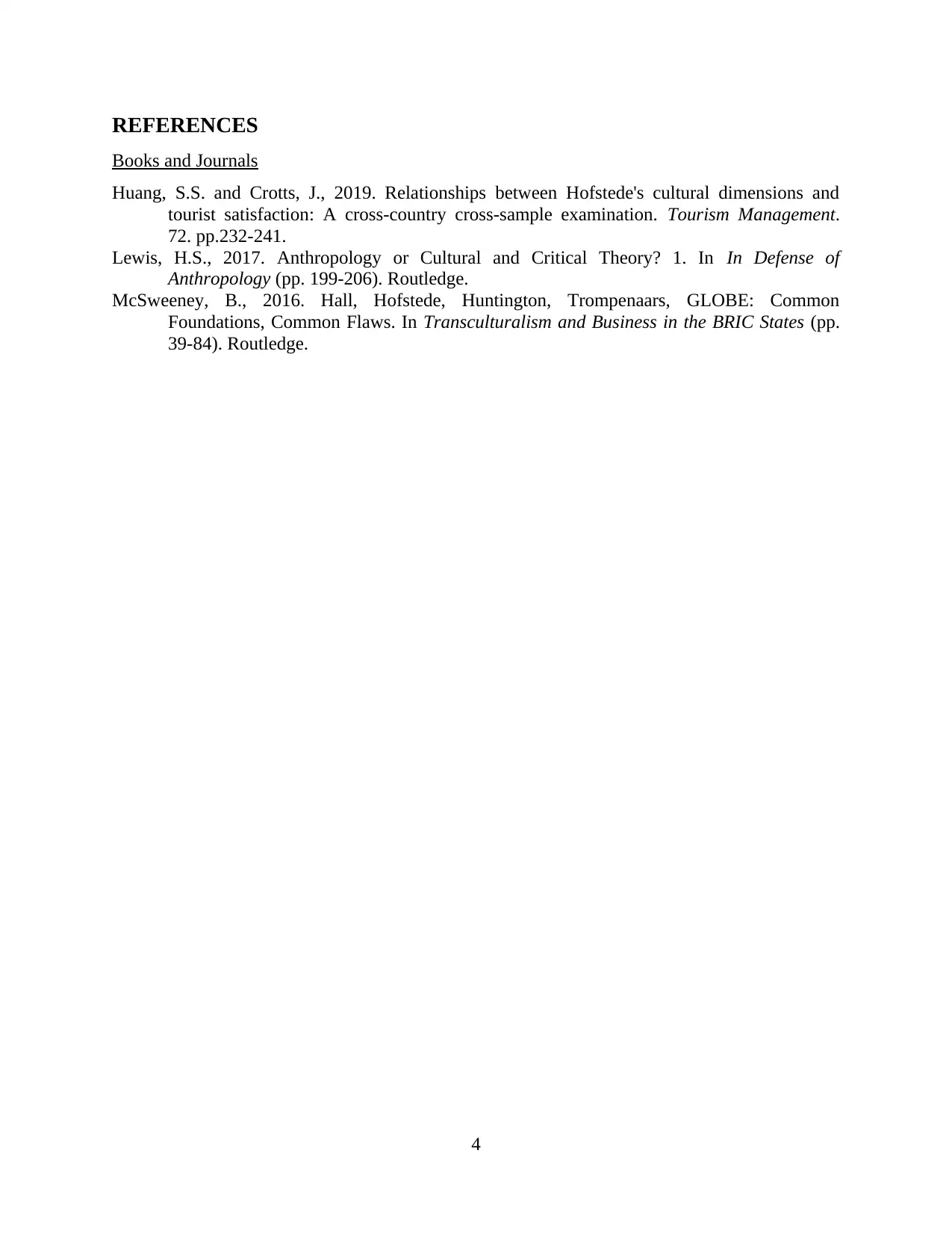
REFERENCES
Books and Journals
Huang, S.S. and Crotts, J., 2019. Relationships between Hofstede's cultural dimensions and
tourist satisfaction: A cross-country cross-sample examination. Tourism Management.
72. pp.232-241.
Lewis, H.S., 2017. Anthropology or Cultural and Critical Theory? 1. In In Defense of
Anthropology (pp. 199-206). Routledge.
McSweeney, B., 2016. Hall, Hofstede, Huntington, Trompenaars, GLOBE: Common
Foundations, Common Flaws. In Transculturalism and Business in the BRIC States (pp.
39-84). Routledge.
4
Books and Journals
Huang, S.S. and Crotts, J., 2019. Relationships between Hofstede's cultural dimensions and
tourist satisfaction: A cross-country cross-sample examination. Tourism Management.
72. pp.232-241.
Lewis, H.S., 2017. Anthropology or Cultural and Critical Theory? 1. In In Defense of
Anthropology (pp. 199-206). Routledge.
McSweeney, B., 2016. Hall, Hofstede, Huntington, Trompenaars, GLOBE: Common
Foundations, Common Flaws. In Transculturalism and Business in the BRIC States (pp.
39-84). Routledge.
4
⊘ This is a preview!⊘
Do you want full access?
Subscribe today to unlock all pages.

Trusted by 1+ million students worldwide
1 out of 6
Related Documents
Your All-in-One AI-Powered Toolkit for Academic Success.
+13062052269
info@desklib.com
Available 24*7 on WhatsApp / Email
![[object Object]](/_next/static/media/star-bottom.7253800d.svg)
Unlock your academic potential
Copyright © 2020–2025 A2Z Services. All Rights Reserved. Developed and managed by ZUCOL.





